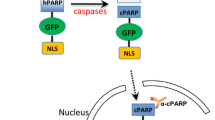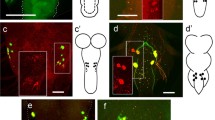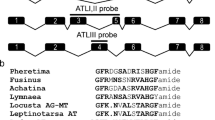Abstract
Metamorphosis is a fundamental developmental process and has been intensively studied for various neuron types of Drosophila melanogaster. However, detailed accounts of the fate of identified peptidergic neurons are rare. We have performed a detailed study of the larval morphology and pupal remodelling of identified peptidergic neurons, the CAPA-expressing Va neurons of D. melanogaster. In the larva, Va neurons innervate abdominal median and transverse nerves that are typically associated with perisympathetic organs (PSOs), major neurohaemal release sites in insects. Since median and transverse nerves are lacking in the adult, Va neurites have to undergo substantial remodelling during metamorphosis. We have examined the hitherto uncharacterised gross morphology of the thoracic PSOs and the abdominal median and transverse nerves by scanning electron microscopy and found that the complete reduction of these structures during metamorphosis starts around pupal stage P7 and is completed at P9. Concomitantly, neurite pruning of the Va neurons begins at P6 and is preceded by the high expression of the ecdysone receptor (EcR) subtype B1 in late L3 larvae and the first pupal stages. New neuritic outgrowth mainly occurs from P7-P9 and coincides with the expression of EcR-A, indicating that the remodelling of the Va neurons is under ecdysteroid control. Immunogold-labelling has located the CAPA peptides to large translucent vesicles, which are released from the transverse nerves, as suggested by fusion profiles. Hence, the transverse nerves may serve a neurohaemal function in D. melanogaster.









Similar content being viewed by others
References
Allan DW, St. Pierre SE, Miguel-Aliaga I, Thor S (2003) Specification of neuropeptide cell identity by the integration of retrograde BMP signaling and a combinatorial transcription factor code. Cell 113:73–86
Bainbridge SP, Bownes M (1981) Staging the metamorphosis of Drosophila melanogaster. J Embryol Exp Morphol 66:57–80
Baudry-Partiaoglou N (1983) Ultrastructure of perisympathetic organs in insects. In: Gupta AP (ed) Neurohemal organs in arthropods. Thomas, Springfield, Ill., pp 513–551
Brady J, Maddrell SHP (1967) Neurohaemal organs in the medial nervous system of insects. Z Zellforsch 76:389–404
Cabrero P, Radford JC, Broderick KE, Costes L, Veenstra JA, Spana EP, Davies SA, Dow JAT (2002) The Dh gene of Drosophila melanogaster encodes a diuretic peptide that acts through cyclic AMP. J Exp Biol 205:3799–3807
Cannata MA, Morris JF (1973) Changes in the appearance of hypothalamo-neurohypophysial neurosecretory granules associated with their maturation. J Endocrinol 56:91–98
Cheng Y, Endo K, Wu K, Rodan AR, Heberlein U, Davis RL (2001) Drosophila fasciclinII is required for the formation of odor memories and for normal sensitivity to alcohol. Cell 105:757–768
Chiang C, Patel NH, Young KE, Beachy PA (1994) The novel homeodomain gene buttonless specifies differentiation and axonal guidance functions of Drosophila dorsal median cells. Development 120:3581–3593
Choi MY, Rafaeli A, Jurenka RA (2001) Pyrokinin/PBAN-like peptides in the central nervous system of Drosophila melanogaster. Cell Tissue Res 306:459–465
Dai JD, Gilbert LI (1991) Metamorphosis of the corpus allatum and degeneration of the prothoracic glands during the larval-pupal-adult transformation of Drosophila melanogaster: a cytophysiological analysis of the ring gland. Dev Biol 144:309–326
Dellmann HD, Sikora-Vanmeter KC (1982) Reversible fine structural changes in the supraoptic nucleus of the rat following intraventricular administration of colchicine. Brain Res Bull 8:171–182
Douglas WW, Nagasawa J, Schulz R (1970) Electron microscopic studies on the mechanism of secretion of posterior pituitary hormones and significance of microvesicles (“synaptic vesicles”): evidence of secretion by exocytosis and formation of microvesicles as a byproduct of this process. Mem Soc Endocrinol 19:353–377
Eckert M, Predel R, Gundel M (1999) Periviscerokinin-like immunoreactivity in the nervous system of the American cockroach. Cell Tissue Res 295:159–170
Eckert M, Herbert Z, Pollák E, Molnár L, Predel R (2002) Identical cellular distribution of all abundant neuropeptides in the major abdominal neurohemal system of an insect (Periplaneta americana). J Comp Neurol 452:264–275
Ewer J (2005) Behavioral actions of neuropeptides in invertebrates: insights from Drosophila. Horm Behav 48:418–429
Finlayson LH, Osborne MP (1968) Peripheral neurosecretory cells in the stick insect (Carausius morosus) and the blowfly larva (Phormia terra-novae). J Insect Physiol 14:1793–1801
Gorczyca MG, Phillis RW, Budnik V (1994) The role of tinman, a mesodermal cell fate gene, in axon pathfinding during the development of the transverse nerve in Drosophila. Development 120:2143–2152
Grenningloh G, Rehm EJ, Goodman CS (1991) Genetic analysis of growth cone guidance in Drosophila: fasciclin II functions as a neuronal recognition molecule. Cell 67:45–57
Grillot JP (1983) Morphology and evolution of perisympathetic organs in insects. In: Gupta AP (ed) Neurohemal organs of arthropods. Thomas, Springfield, Ill., pp 481–512
Johnson EC, Shafer OT, Trigg JS, Park J, Schooley DA, Dow JA, Taghert PH (2005) A novel diuretic hormone receptor in Drosophila: evidence for conservation of CGRP signaling. J Exp Biol 208:1239–1246
Kean L, Cazenave W, Costes L, Broderick KE, Graham S, Pollock VP, Davies SA, Veenstra JA, Dow JAT (2002) Two nitridergic peptides are encoded by the gene capability in Drosophila melanogaster. Am J Physiol 282:R1297–R1307
Landgraf M, Sánchez-Soriano N, Technau GM, Urban J, Prokop A (2003) Charting the Drosophila neuropile: a strategy for the standardised characterisation of the genetically amenable neurites. Dev Biol 260:207–225
Lin D, Fetter RD, Kopczynski C, Grenningloh G, Goodman CS (1994) Genetic analysis of fasciclin II in Drosophila: defasciculation, refasciculation, and altered fasciculation. Neuron 13:1055–1069
Miksys S, Lange AB, Orchard I, Wong V (1997) Localization and neurohemal release of FMRFamide-related peptides in the stick insect Carausius morosus. Peptides 18:27–40
Morris JF, Dyball REJ (1974) A quantitative study of the ultrastructural changes in the hypothalamo-neurohypophysial system during and after experimentally induced hypersecretion. Cell Tissue Res 149:525–535
Morris JF, Nordmann JJ (1982) Membrane retrieval by vacuoles after exocytosis in the neural lobe of Brattleboro rats. Neuroscience 7:1631–1639
Nässel DR, Elekes K (1985) Serotonergic terminals in the neural sheath of the blowfly nervous system: electron microscopical immunocytochemistry and 5,7-dihydroxytryptamine labeling. Neuroscience 15:293–307
Nässel DR, Ohlsson LG, Cantera R (1988) Metamorphosis of identified neurons innervating thoracic neurohemal organs in the blowfly: transformation of cholecystokininlike immunoreactive neurons. J Comp Neurol 267:343–356
Nässel DR, Bayraktaroglu E, Dircksen H (1994) Neuropeptides in neurosecretory and efferent neural systems of insect thoracic and abdominal ganglia. Zool Sci 11:15–31
O’Brien MA, Taghert PH (1998) A peritracheal neuropeptide system in insects: release of myomodulin-like peptides at ecdysis. J Exp Biol 201:193–209
Osborne MP (1964) The structure of the unpaired ventral nerves in the blowfly larva. Q J Microsc Sci 105:325–329
Pollák E, Eckert M, Molnár L, Predel R (2005) Differential sorting and packaging of capa-gene related products in an insect. J Comp Neurol 481:84–95
Pollock VP, McGettigan J, Cabrero P, Maudlin IM, Dow JAT, Davies SA (2004) Conservation of Capa peptide-induced nitric oxide signalling in Diptera. J Exp Biol 207:4135–4145
Pow DV, Morris JF (1991) Membrane routing during exocytosis in neuroendocrine neurones and endocrine cells: use of colloidal gold particles and immunocytochemical discrimination of membrane compartments. Cell Tissue Res 264:299–316
Predel R, Russell WK, Tichy SE, Russell DH, Nachman RJ (2003a) Mass spectrometric analysis of putative Capa-gene products in Musca domestica and Neobellieria bullata. Peptides 24:1487–1491
Predel R, Herbert Z, Eckert M (2003b) Neuropeptides in perisympathetic organs of Manduca sexta: specific composition and changes during development. Peptides 24:1457–1464
Predel R, Wegener C, Russell WK, Tichy SE, Russell DH, Nachman RJ (2004) Peptidomics of CNS-associated neurohemal systems of adult Drosophila melanogaster: a mass spectrometric survey of peptides from individual flies. J Comp Neurol 474:379–392
Sánchez-Soriano N, Prokop A (2005) The influence of pioneer neurons on a growing motor nerve in Drosophila requires the neural cell adhesion molecule homolog fasciclin II. J Neurosci 25:78–87
Schooneveld H (1974) Ultrastructure of the neurosecretory system of the Colorado potato beetle, Leptinotarsa decemlineata (Say). Cell Tissue Res 154:275–288
Schubiger M, Wade AA, Carney GE, Truman JW, Bender M (1998) Drosophila EcR-B ecdysone receptor isoforms are required for larval molting and for neuron remodeling during metamorphosis. Development 125:2053–2062
Schubiger M, Tomita S, Sung C, Robinow S, Truman JW (2003) Isoform specific control of gene activity in vivo by the Drosophila ecdysone receptor. Mech Dev 120:909–918
Sivasubramanian P (1991) FMRFamide-like immunoreactivity in the ventral ganglion of the fly Sarcophaga bullata: metamorphic changes. Comp Biochem Physiol [C] 99:507–512
Smith U, Smith DS (1966) Observations on the secretory processes in the corpus cardiacum of the stick insect, Carausius morosus. J Cell Sci 1:59–66
Taghert PH (1999) FMRFamide neuropeptides and neuropeptide-associated enzymes in Drosophila. Microsc Res Tech 45:80–95
Talbot WS, Swyryd EA, Hogness DS (1993) Drosophila tissues with different metamorphic responses to ecdysone express different ecdysone receptor isoforms. Cell 73:1323–1337
Terhzaz S, O’Connell FC, Pollock VP, Kean L, Davies SA, Veenstra JA, Dow JAT (1999) Isolation and characterization of a leucokinin-like peptide of Drosophila melanogaster. J Exp Biol 202:3667–3676
Tissot M, Stocker RF (2000) Metamorphosis in Drosophila and other insects: the fate of neurons throughout the stages. Progr Neurobiol 62:89–111
Truman JW (1990) Metamorphosis of the central nervous system of Drosophila. J Neurobiol 21:1072–1084
Truman JW, Talbot WS, Fahrbach SE, Hogness DS (1994) Ecdysone receptor expression in the CNS correlates with stage-specific responses to ecdysteroids during Drosophila and Manduca development. Development 120:219–234
Vallés AN, White K (1988) Serotonin-containing neurons in Drosophila melanogaster: development and distribution. J Comp Neurol 268:414–428
Wegener C, Linde D, Eckert M (2001) Periviscerokinins in cockroaches: release, localization, and taxon-specific action on the hyperneural muscle. Gen Comp Endocrinol 121:1–12
Wegener C, Herbert Z, Eckert M, Predel R (2002) The periviscerokinin (PVK) peptide family in insects: evidence for the inclusion of CAP2b as a PVK family member. Peptides 23:605–611
Wegener C, Reinl T, Jänsch L, Predel R (2006) Direct mass spectrometric peptide profiling and fragmentation of larval peptide hormone release sites in Drosophila melanogaster reveals tagma-specific peptide expression and differential processing. J Neurochem 96:1362–1374
Williams DW, Truman JW (2005) Remodeling dendrites during insect metamorphosis. J Neurobiol 64:24–33
Acknowledgements
We express our thanks to Stefan Thor, Stéphane Noselli, Paul Taghert and the Bloomington Stock Center for the kind gift of flies, to Manfred Eckert and the DSHB for the kind gift of antibodies, to Petra Touzani for excellent technical help with the preparations for SEM, to Reinhard Predel, Heinrich Dircksen and Joachim Schachtner for useful suggestions, to Ruth Hyland and Renate Renkawitz-Pohl for providing fly housing, to Ian Orchard for hints regarding the older literature, to Wolf Huetteroth for expert advise with Amira, to Matthias Vömel for contributing to the layout of the Fas2 scheme, and to Uwe Homberg for general support.
Author information
Authors and Affiliations
Corresponding author
Additional information
This work was supported by the German Science Foundation (Deutsche Forschungsgemeinschaft, DFG), grant We 2652/2-1.
Rights and permissions
About this article
Cite this article
Santos, J.G., Pollák, E., Rexer, KH. et al. Morphology and metamorphosis of the peptidergic Va neurons and the median nerve system of the fruit fly, Drosophila melanogaster . Cell Tissue Res 326, 187–199 (2006). https://doi.org/10.1007/s00441-006-0211-7
Received:
Accepted:
Published:
Issue Date:
DOI: https://doi.org/10.1007/s00441-006-0211-7




